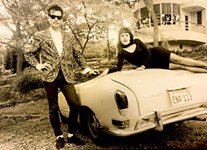'Bad Boy Brawly Brown' Reviewed
Has Walter Mosley's seventh novel in the Easy Rawlins series lived up to its predecessors? Jesse Sublett lets you know in his review of Bad Boy Brawly Brown.
By Jesse Sublett, Fri., Oct. 18, 2002
Bad Boy Brawly Brown
by Walter MosleyLittle, Brown, 311 pp., $24.95
Bad Boy Brawly Brown, Walter Mosley's seventh crime novel featuring Eziekiel "Easy" Rawlins, does all the best things that a piece of noir can do, and does more of it better than most. Mosley introduced Rawlins in his 1990 debut, Devil in a Blue Dress. Back then, he was a black factory worker struggling to survive in the Watts section of Los Angeles in 1948. Mosley's latest finds Rawlins a successful black businessman in a tumultuous time. The year is 1964, just after the JFK assassination and before the Watts riots, and Rawlins is trying to live a quiet life with his two adopted children and his beautiful, brilliant girlfriend, Bonnie.
Rawlins assumes his old role as a man who does "favors" for friends and neighbors when a woman named Alva asks him to look for her son, a troubled, towering, and temperamental 23-year-old named Brawly Brown. Brawly has gotten mixed up with a radical group called the First Men, and Alva's justifiably worried that he's in over his head. Almost immediately, Rawlins stumbles over one dead body and witnesses the assassination of one of the leaders of the First Men. He's soon entangled in a web of deceit and duplicity whose strands include a secret police group that tries to enlist him as an informant, and the inner circle of the First Men, who have recruited Brawly in a violent and ill-fated scheme.
Despite his adventures in the world of shadows and bad men, Easy Rawlins is first and foremost a family man. Remove this context and his heroics would have neither meaning nor purpose. In Bad Boy Brawly Brown, Rawlins is still an edgy character, but he feels the weight of his familial responsibilities more than ever. Besides his two adopted children, he has a pint-sized dog that despises him, inherited from the previous Rawlins novel, A Little Yellow Dog. It was in that novel that the most appealing of Mosley's characters, Rawlins' violent and charismatic friend, Raymond "Mouse" Alexander, went down in a hail of bullets. There's a bit of awkwardness in this novel, as Mosley seems to be tempted by the possibility of bringing Mouse back to life. In a way, I hope he doesn't; the fact that Mouse isn't around to come riding to Easy's rescue by gunning down everyone else in sight adds new tension and originality to this fine series of stories.
Mosley's work not only represents some of the best, most artful modern work in the Dashiell Hammett/Raymond Chandler detective tradition, but a body of American literature that's in some ways more realistic and authentic than the masters'. This is true despite the fact that Rawlins isn't a detective, just a guy helping friends and neighbors by using his unique talents and connections. And in the racially charged, virtual police state of Rawlins' era, the danger to his life, as well as the threat he represents to the white establishment, is a very real and credible one -- unlike the environment of the traditional, white detective, whose reputation as a one-man Justice League is mostly a literary conceit. What also makes Mosley's writing rock is his gift of language: Whether describing violence or heartache, a juke joint or a temptress on the other side of a screen door, Mosley's spare, lyrical prose is as pitch perfect and evocative as an Al Green ballad. It's language that makes these books sing. It's also the reason people like me read them.
Walter Mosley will read from Bad Boy Brawly Brown at Bouchercon 2002 on Thursday, Oct. 17, 3pm at the Renaissance Hotel. He'll also take part in the "Suspense in Lonely Places" panel at 1:30pm on Friday, Oct. 18.








